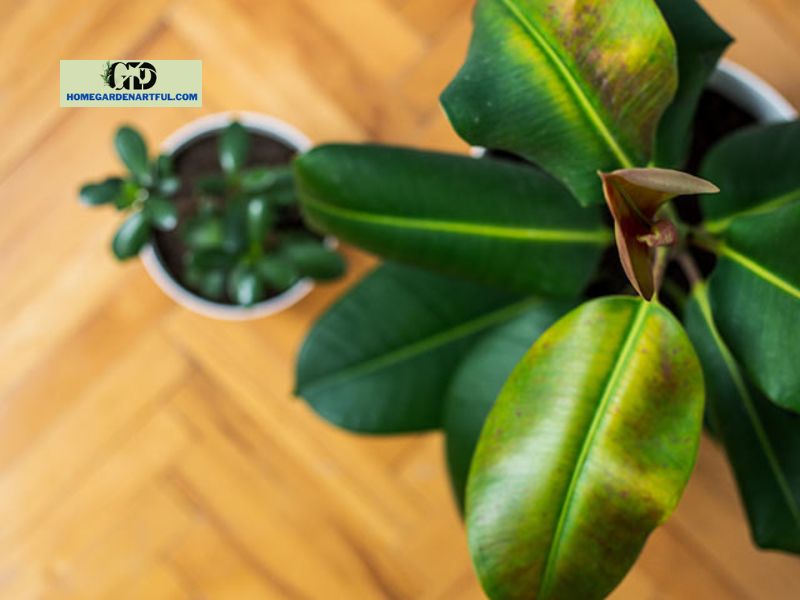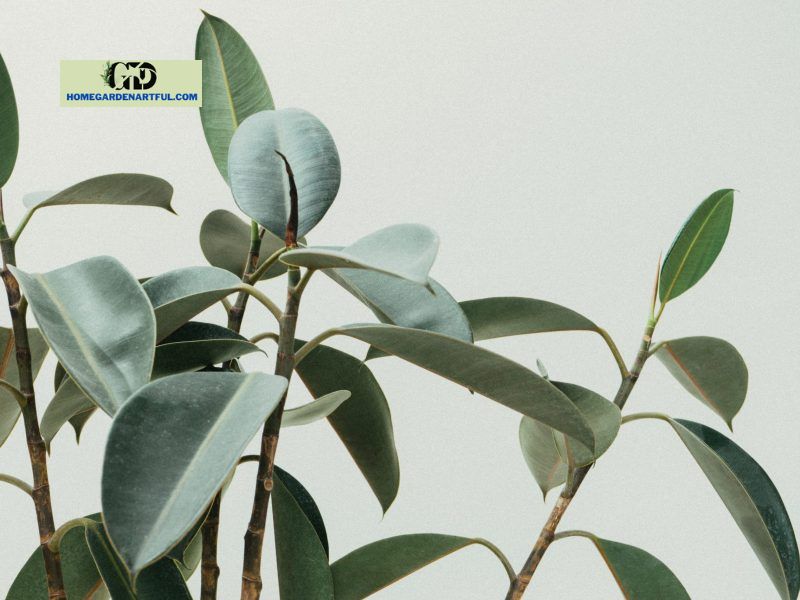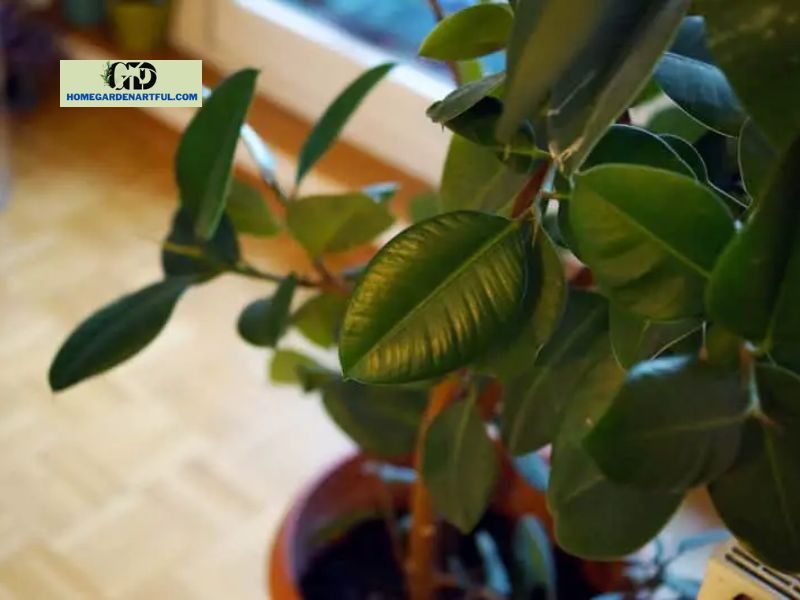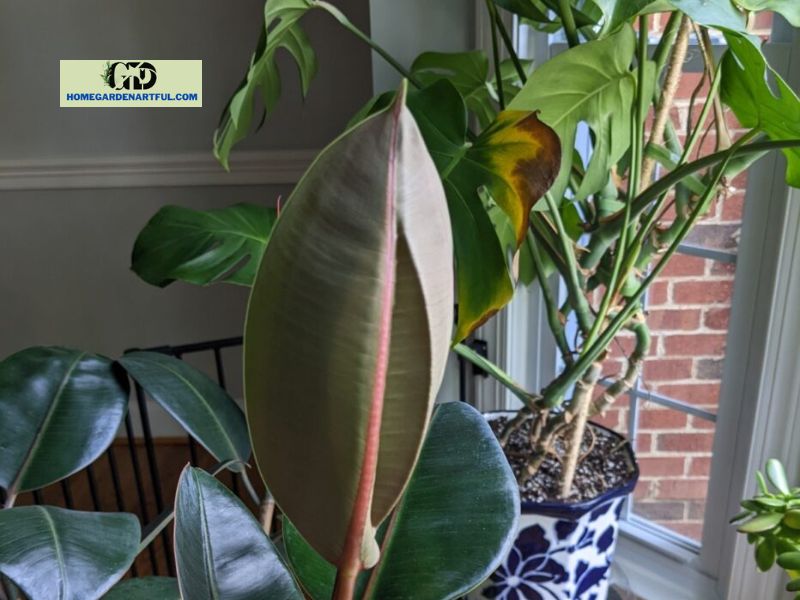Curled Rubber Plant Leaves? Rubber tree plants, Ficus elasticas, are fast-growing trees belonging to tropical Asia’s fig family.
They were employed to create an inferior kind of rubber in the early 1900s. However, because of its low maintenance and adaptability, the rubber tree now makes an excellent houseplant.
Despite their forgiving nature, rubber trees are subject to leaf curling problems, which can swiftly lead to plant death. This article from homegardenartful.com deconstructs the reasons for particular symptoms and offers solutions to those issues.
Why do Curled Rubber Plant Leaves happen?

The most prevalent reasons for leaf curling in rubber tree plants include environmental factors such as soil moisture levels, climate, nutrition availability, and fungal infestations.
Leaf chlorosis, or leaf yellowing, frequently precedes leaf curling and might be the first symptom of a problem with your rubber tree, so keep an eye out for any color changes in your rubber plant’s generally glossy, deep emerald-green leaves.
Causes of Curled Rubber Plant Leaves

The signs listed below will assist you in determining the cause and remedy of your rubber plant’s curled leaves.
Curling Upward
When the leaves of a rubber plant curl upwards, it is frequently a symptom of a lack of soil moisture caused by underwatering and the rubber plant’s attempt to restrict transpiration and further water loss.
Leaf chlorosis, wilting, and crisping of the leaf edges are likely to accompany leaf curling due to nutrient deficits induced by root mortality if the condition is severe.
How to Fix:
Water the rubber plant immediately with enough liquid to fill the container and let it drain. Repeat daily for 2 – 3 days, or until you notice it beginning to recover.
Then, water when the top two inches of soil are dry, which is normally twice a week during the warm months and once a week during the colder months.
Curling Downwards
Rubber tree leaves curl downward as a result of moist soil caused by overwatering. It is frequently associated with pale, yellow, wilted leaves and stunted development as a result of nutrient deficits produced by root rot.
How to Fix:
Remove any excess water from the catch tray as well as allow the soil to dry before watering again.
If the soil around your rubber tree frequently absorbs too much moisture, transplant it into a well-draining soil mix like this:
- 1 part sand
- 4 parts sedge peat
- Dolomite density of 4.2 kg/m3
- Calcium Carbonate (CaCO3) at 1.8 kg/m3
- 0.6 kg/m3 of granular fertilizer with general micronutrients
Yellowing and curling

The most prevalent reason for curling and yellowing leaves on rubber tree plants is a lack of nutrients. Nitrogen causes lower leaves to yellow and curl. Browning as well as leaf drop will occur as a result.
- Potassium – Interveinal yellowing of the entire plant, subsequently followed by leaf curling and browning leaf margins, are symptoms.
- Phosphorus causes older leaves to curl and distort. This is frequently accompanied by leaf withering and browning.
- Calcium – This is when the leaf edges curl and the leaf border becomes dark. Tissue death and severely stunted growth are also possible outcomes.
How to Fix:
The University of Florida recommends using a slow-release granule fertilizer with an N-P-K ratio of 18-3-10 at a rate of 27g per 30cm container every six months.
If your plant is suffering from serious nutrient deficits, I propose giving it a tropical houseplant-specific liquid fertilizer with a low N-P-K rating of 1-0.5-1 while you wait for the granules to work.
Curling and Browning of Top Leaves
Curling leaves and unevenly shaped browned burnt areas indicate sun damage.
All rubber plant kinds are tropical understory species that thrive in partial to full sun. Since many larger rubber trees can tolerate full sun, their leaves are lighter and less glossy than those that thrive in shade.
In full sun, smaller single-stemmed rubber tree houseplants are difficult to survive.
How to Fix:
Relocate your rubber tree to an area with at least 7 hours of bright, indirect sunlight. When the plant has recovered, water thoroughly and trim any dead leaves.
At first, the new Rubber Plant leaves curl.
If only the new leaves of your Rubber Plant are curling or wrinkling, this is normal. As new leaves sprout, they will be tightly curled and shoot up from the main stalk. The leaf will gradually uncurl as it matures. As long as the leaf progressively uncurls and all of the other leaves appear healthy, you have nothing to worry about; it is simply your plant maturing!
Curling Rubber Plant leaves isn’t something you should be concerned about. Rubber plants will not die on you if something is wrong, so just keep an eye on their environment as well as your care for a few weeks to identify any obvious abnormalities.


